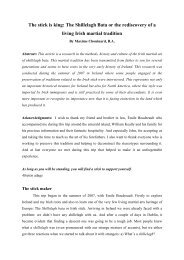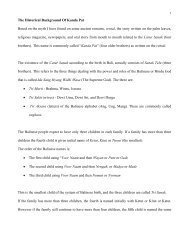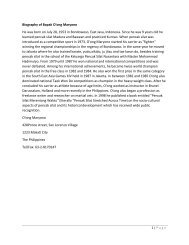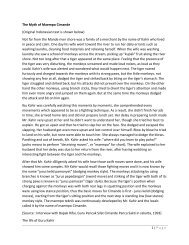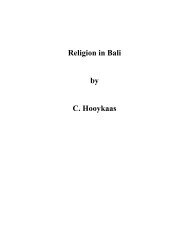Tenaga Dalam - Pukulan Cimande Pusaka
Tenaga Dalam - Pukulan Cimande Pusaka
Tenaga Dalam - Pukulan Cimande Pusaka
You also want an ePaper? Increase the reach of your titles
YUMPU automatically turns print PDFs into web optimized ePapers that Google loves.
DJAKARTA<br />
EX ‘PEARL OF THE EAST’<br />
The following is a passage from the wonderful<br />
book Magic and Mystics of Java by Nina Epton,<br />
Octagon Press, ISBN 0-900860-39-1. The book is<br />
a “must have” and is about one woman and her<br />
search to find the “old ways”. It also contains rare<br />
information on the Badui tribe who live in West<br />
Java. There are only three sources that I have ever<br />
seen on this elusive tribe, i.e. the 1817 book History<br />
of Java by Thomas Ruffles, this book and a video<br />
tape sold by Herman Suwanda - Survey 1 of Silat<br />
in Java.<br />
As we approached a larger island than the rest,<br />
half-hidden by mist and dotted with smoky blue<br />
pyramids-smoky and smoking, for Java’s<br />
volcanoes are very much alive - I looked down a<br />
little apprehensively, wondering whether I would<br />
succeed in the quests I had set myself.<br />
I had flown halfway round the world to wrest three<br />
secrets from this lovely, little-known island. I<br />
wished to see the ‘Invisible People’ - a remote<br />
jungle tribe in West Java; I wished to probe into<br />
ancient court ceremonial at the palace of the Sultan<br />
of Jogjakarta, near the south coast, and I wished to<br />
meet Javanese mystics and magicians. My friends<br />
in Indonesia had already warned me that these<br />
would be very difficult tasks to achieve.<br />
Djakarta lies on the northern coast of Java; this is<br />
the flattest and least interesting of her coasts and<br />
unfortunately it is this side that confronts visitors<br />
arriving from the West. All they see from the<br />
aeroplane is a lead-coloured line of sand beaten by<br />
waves seeping into a land as flat as Holland. The<br />
Dutch settlers who came here in 1618 and founded<br />
Batavia must have thought it strangely like their<br />
homeland. Scattered clumps of coconut palms like<br />
abandoned umbrellas are the only proof that this is<br />
no northern territory.<br />
The capital of Indonesia sprawled beneath the<br />
aircraft-dirty white, almost treeless and<br />
criss-crossed by Dutch-built canals. As we circled<br />
lower I saw the lean form of a sedate Dutch<br />
Reformed church set beside a park surrounded by<br />
villas and bungalows. This used to be the Dutch<br />
residential area in the old colonial days when<br />
Batavia was still known as ‘the Pearl of the East’.<br />
It is difficult to think of Batavia, and still less of<br />
Djakarta, as a pearl -at least not from a scenic or<br />
an architectural point of view. This name must have<br />
been bestowed upon the capital as a symbol of the<br />
wealth amassed there from the products of the<br />
Indonesian archipelago: tea, coffee, tin, palm oil,<br />
spices. Spanish, Portuguese, Dutch, and English<br />
fought each other bitterly to get this lucrative trade,<br />
so much so that even a saint like Francis Xavier,<br />
who came here to save -heathen souls, could not<br />
fail to remark how very rapacious we Christians<br />
were.<br />
The moment you land at Djakarta the hot, humid<br />
atmosphere seizes you and strips away all energy.<br />
None has described it with more admirable effect<br />
than Lt. Stockdale, who traveled through Java in<br />
1811:<br />
‘Most of the people who live here and even many<br />
of the rich who might be supposed to have attained<br />
3





